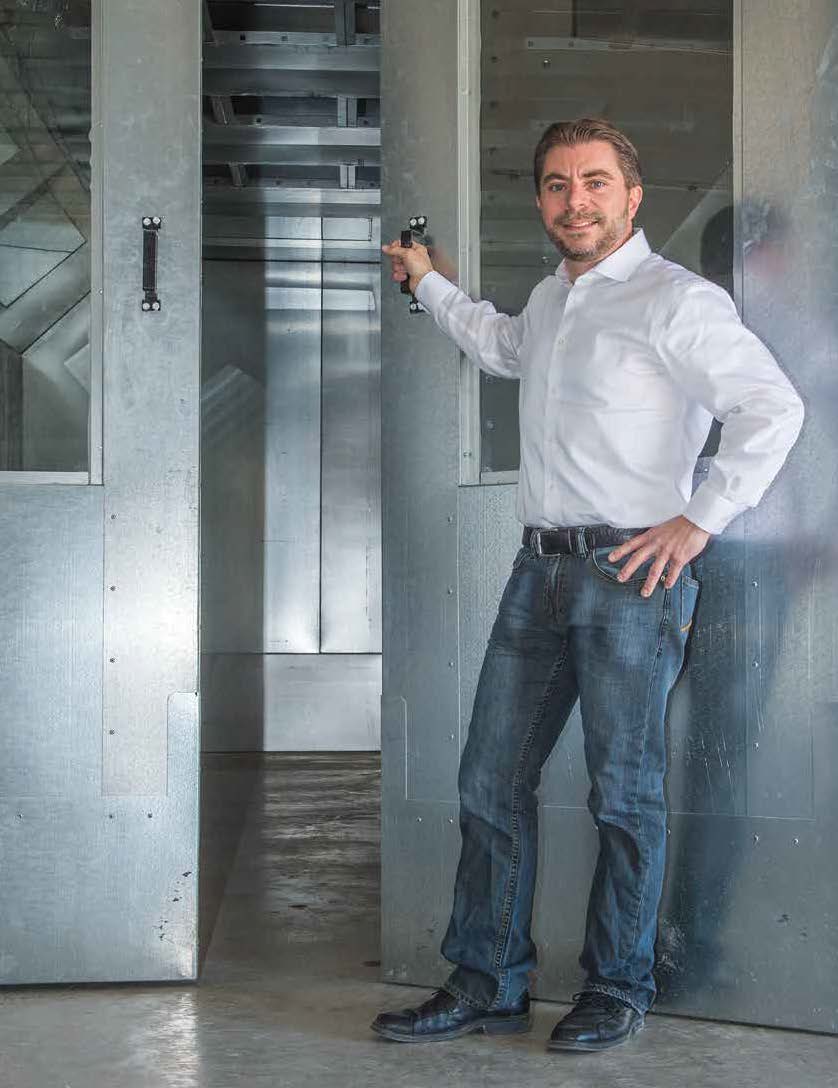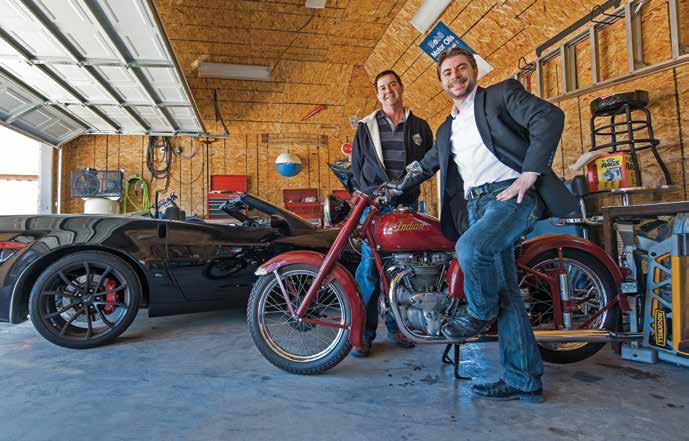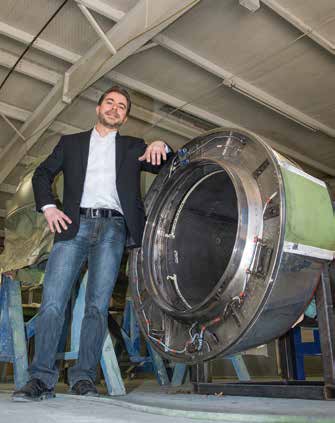
Don Snodgrass President of Dallas Aeronautical Services


Don Snodgrass was going through his desk drawers in March, throwing away junk and packing up stuff he wanted to keep in advance of his company’s move to its new facility. This led him to find a couple of relics from a wildly circuitous global aviation career path that took him from a farm south of Dallas all the way back to … well, a metal building south of Dallas.
Snodgrass, president of Dallas Aeronautical Services (DAS), tossed a couple of old, yellowed and wrinkled clip-on company ID badges onto the conference table. One was from a now-defunct aviation repair company in nearby Grand Prairie, where 24 years ago he worked on the re-skinning of a by-then-already-ancient Douglas DC-8’s flight controls. The other was from an aviation composite components repair shop, also now defunct, in Wichita, KS, where after only two months on the job — at age 21 — he was named general manager. Since then he has had a number of other career stops in places like Oklahoma City; Munich, Germany; Prestwick, Scotland; Lisbon, Portugal; and El Salvador.
Ten years ago, feeling the need to be closer to home, Snodgrass returned to the Dallas area and set up shop as a consultant. He advised international airlines, corporate aircraft fleet operators and repair shops around the world on both the science and the art of fixing and, when necessary, making composite aircraft parts. He didn’t plan on opening his own aircraft repair station. However, his understanding of composites was in high demand, and he had developed solid business management skills along the way, so the notion of actually opening up his own shop would not go away. Still, the idea of having to beat the bushes to find aircraft in need of repair, especially with his kind of expertise, was not at all appealing.
Then, in 2005, all of that changed when two things happened. First, Snodgrass became utterly convinced there was a strong and largely unmet demand for the kind of specialty aviation repair services in which he was an expert. Second, he reconnected with long-time industry acquaintance Mike Manning.
“I knew the technical and business side, but in 2005 I didn’t really know the marketing side of the business that well,” says Snodgrass. “Mike had been in sales and planning in the industry for years. I’d worked with Mike, and even worked against Mike at various companies, and I knew how good he was. So when we reconnected, we knew we could build this together. He became my full partner right away.”
Together they converted DAS from a one-man consulting firm into a fully-certified Part 145 repair station and began taking in repair business in late 2005.
In mid-December 2009 the company got a call from the U.S. Air Force. They needed a quick turnaround by Christmas on the repair of a composite flight control component on a very special airplane — VC25. It is one of two heavily-modified Boeing 747-400s that when a certain regular passenger is onboard becomes the ultimate VIP aircraft.
“It was a very short turnaround, but we pulled it off,” says Snodgrass. “That’s the reason they called on us. We have a reputation for knowing what we’re doing and being able to respond quickly because we don’t have a big corporate bureaucracy.”
THE EARLY YEARS
Snodgrass’ aviation career began at an unusually early age, and his career as a mechanic began even earlier. Growing up on a small farm outside the small town of Palmer, TX, (“Population 1,234 when I was a kid,” he likes to say), he learned to fix tractors and weld by age 10. By age 11, he was driving a stick-shift pickup truck with a cattle trailer on the back as he helped with farm chores.
“I worked on a cattle ranch growing up as a teenager. That’s hard work,” he says. It was hard enough that he determined quickly that he did not want to spend his life there. By his senior year in high school, since he only needed one more class to graduate, he started working almost full time as a mechanic at a Ryder Trucks’ support facility in south Dallas. He used his connections at Ryder (five of his uncles worked there at the time) to get a job rebuilding trailers in the body shop.
“My dad was also in the trucking business,” he explains. “He helped build Roadway in the seventies and eighties. My dream was to open a shop when I got out of high school to repair my dad’s trucks. But just about the time I was getting out of school, he sold his portion of the company to FedEx and retired. So much for that dream.”
Immediately upon graduating as one of only 27 members of the Palmer High Class of 1988, the in-a-hurry-to-grow-up Snodgrass and his high school sweetheart married. Her brother just happened to be an A&P mechanic in the Dallas area.
“I hated coming home smelling like diesel,” says Snodgrass. “I wanted something more.” With his brother-in-law’s encouragement and connections, he landed a job at Diab Barracuda Technologies as an aviation sheet metal mechanic.
“Since I had trailer experience from Ryder, I already knew how to shoot rivets, so they took me on.” he says.
Snodgrass spent a year there, mostly working on the old DC-8s and 727s, before moving to HAC Corporation, an aircraft composites repair shop in Grand Prairie, where he spent the next two years. While there, he learned enough about working with composite materials that a headhunter sought him out for a position in Wichita to work for a small company that made composite parts for Learjet and Bombardier aircraft.
“They were desperately trying to expand and get into the repair business,” says Snodgrass. “I was 20 at the time, and the composites thing just always seemed to click with me. I got it and I understood it so I took the job. The company was sold in less than a year, just for its tooling.”
He returned to Texas and got his old job back at HAC where he ran the company’s composites and bond shop for seven years. In only his second year there, Dallas-based Southwest Airlines called for help. Southwest, like most airlines in those days, only did limited maintenance and repairs to composites — most composite flight controls were just removed and replaced. But in the endless quest to lower costs, the airline wanted to learn how to do its own composite repair work. For the next four months, Snodgrass and other HAC composites experts worked with Southwest’s top two composites mechanics, tutoring them not only on the ins and outs of working with composite materials, but also how to pass that knowledge to other mechanics at Southwest.
While at HAC, Snodgrass took advanced composite repair and engineering classes taught at Boeing in Seattle — and, he’s quick to add, recorded perfect scores on both programs’ concluding tests. His experience and certifications led to offers from Chevrolet, Dodge and a number of other companies interested in expanding their use of weight-saving composites. He turned them all down, until 1998.
“There was a new company here in Dallas: Aero Fabricators,” he says. “They were connected to the international corporate jet makers. They asked me to set up the (composites) shop and run it, and possibly run the company in a few years.” By 2002 he was named chief operating officer, overseeing a 200,000-square-foot, 260-employee operation in Dallas. “We did complete restoration of composite structures for the entire Douglas, Boeing, Airbus and corporate line of aircraft. From the commercial fleet to the military, we did it.”
TRAVELS AND CHANGES
Aero Fabricators was sold in early 2004 and Snodgrass spent the next several months bouncing between short-term assignments as a consultant, first with Lufthansa Technic Composites in Tulsa, OK, then Munich, and then as a consultant with Aviation Capital Group and ILFC. The move from Lufthansa Technic to ACG didn’t require relocation. In fact, he went to work one day for Lufthansa, and the next for ACG in the exact same hangar in Germany, doing much of the same thing — working on the composite thrust reversers and other composite parts associated with the IAE V2500 engine. ACG then moved him to Prestwick to work on Goodrich Rohr products. He worked on composite thrust reversers and engine nacelle pods for IAEA, GE, CFM and Rolls Royce engines. A short assignment in Portugal, assisting TAP Air Portugal’s mechanics, was followed by one in El Salvador for TACA Airlines. By the fall of 2004, Snodgrass had had enough of living out of a suitcase.
“My whole job throughout that time was teaching, essentially — teaching composite repairs and helping customers understand the depth of their composite components, and helping the (aircraft) leasing companies understand the costs of doing that work on the planes they owned and leased to airlines and corporate users,” says Snodgrass.
“You see, before the early 2000s, the repair world mentality for big damage (to planes) was always ‘return it to the OEMs.’ That started to change in the early 2000s, around 2003-2004. Owner-operators, corporate fleet operators and airlines, they were all starting to re-think the reasons for sending big repairs to the OEMs. They were mostly concerned about long turnaround times, about the quality of repairs and the prices being charged.
“I thought I could help them through that re-thinking process, so I started DAS as a consulting company. I advised a lot of companies in my first year. Most of them were overseas, really big Asian carriers like JAL, All Nippon and others, all the way to the big U.S. companies like United, Northwest and even American. I helped them find fixes for problems they were having, mostly with composites, and finding repair shops that could handle that work for them. I also worked with the aircraft manufacturing companies, finding ways to refine the manufacturing process.
“I had one customer during that time who’d been involved with an old 707 elevator tab job for about a year. They couldn’t get the problem solved.” But, he adds, within 30 days of his arrival, the customer had created and gotten approval for the tooling and parts needed to begin production work.
It was during those post-9/11 days when airlines and other aircraft owners and operators were scrambling to reduce costs any way they could without compromising safety that they began searching for composite repair companies that could think outside the box and help them develop procedures to help with the repair process.

“If they’re not repaired or manufactured correctly, composite components won’t last the full, promised lifecycle,” says Snodgrass. “They will begin to absorb moisture and they will delaminate. My job was helping companies understand not just the engineering that’s involved in working with composites but the art, if you will, of working with composites.”
HOW DAS GREW
After a year in business, Snodgrass became convinced there was enough demand for composite repair work that he could be successful running a repair station specializing in composites repair and fabrication. He enlisted Manning, got FAA certification and began building DAS’ reputation.
Since then, its operation has grown from one small building in a non-descript business park in decidedly down-scale Lancaster in far south Dallas County, into a bustling 45-employee company that occupies 25,000 square feet in seven buildings. It works regularly on composite parts used on Boeing, Bombardier, Gulfstream, Hawker Beechcraft and Piaggio aircraft owned and operated by individual owner/operators, corporations, leasing companies, charter operators, airlines and even the military. DAS also accepts specialty aircraft part repair work largely (or even completely) unrelated to composites.
In April DAS moved from that non-descript business park in Lancaster (only a few miles north of Snodgrass’s hometown) to a brand new, custom-built facility in Cedar Hill, a fast-growing, middle-class Dallas suburb about 10 miles west of Lancaster. At 50,400 square feet, DAS’ new home has more than twice the space in which the company operated in Lancaster. Not only will the additional space allow DAS to increase the amount of work it can accept, Snodgrass says it has also been designed to create a better “flow” as parts arrive and go through the breakdown diagnostic process, and then progress through various stages before being packed for shipping back to the customer. It also houses two autoclaves, two custom paint centers, a complete three-, four- and five-axis high speed CNC machining center, a controlled environment clean room, a large walk-in oven, a full NDT testing lab and a transmissivity test range.
Like the Lancaster facility, DAS’ new home is miles from the nearest airport. That’s by design. Some of the most expensive real estate in America is located at airports. By opting for suburban locations, DAS can keep costs down and prices competitive with larger-volume competitors.

DAS is also expanding internationally. In support of Brazilian airplane maker Embraer, Airbus Helicopters’ Brazilian subsidiary Helibras, and other elements of Brazil’s fast-growing aviation sector, DAS is also expanding the operations of its DAS Brazil subsidiary. Later this year it will move into a new 25,000-square-foot facility in Sao Jose dos Campos. Additional growth in Brazil is possible, depending on the outcome of negotiations with another Brazilian aviation company.
“Almost all aircraft made these days have some composite parts,” says Snodgrass. “Fiberglass, sheet metal over honeycombed paper, and various kinds of resins — they’re all composite materials. People don’t believe me when I say it, but even the early 707s had a large percentage of composite parts. So there’s plenty of demand for companies that have expertise in composite repair, and even fabrication of parts that can’t be fixed, but would cost an arm and a leg if you went to the OEM to get a replacement — if that’s even possible.
“Our Brazil expansion is just as strategic as our move to Cedar Hill. It’s thinking outside the box and positioning ourselves for growth.
“But ultimately this is a relationship business. People in this industry don’t think of ‘DAS,’ they think of ‘Don and Mike.’ They know us. They know the kind of work we do. They know we will do whatever it takes to make them happy with the work we do for them. They know we’ll tell them the truth, even if it’s not what they want to hear.
“You see, I don’t care where you take an aircraft or a part to be fixed, there are always going to be unexpected issues that come up when you’re fixing airplanes. So it’s not a matter of whether the repair shop can handle those issues that do come up, it’s HOW they take care of those issues. And that’s why we say this is ultimately a relationship business. Yes, our customers know we’re really good on composites. But more importantly, they know that we do whatever it takes to make our customers happy.”
